|
Introduction: This was a match of six games played in the Café Kaiserhof Leipzig (1) from Thursday 19th February to Friday 27th February (2) 1914 between Rudolf Spielmann and Richard Teichmann.
Teichmann scored an emphatic victory in the strongly contested match, where all of the games were decisive.
"The match at Leipzig between these masters ... has ended in a brilliant victory for Richard Teichmann, who has once more proved his quality by defeating his powerful antagonist by five games to one, the contest being of six games". (3) "<TEICHMANN BEATS SPIELMANN> The match between Teichmann and Spielmann, which was played in Leipzig, has ended in a decisive victory for Teichmann, who won five games and lost one. The games are of a high order, worthy the reputation of the two masters. In one or two games he reproduced the form he displayed when he won the Karlsbad (1911) international tournament, and in these Spielmann could not more than resist for about twenty moves. It has always been a surprise to the chess world that Teichmann has not taken part in more matches. His style of play is particularly adapted for individual contests, and one critic gave his opinion that Teichmann had as much chess in him as any other master." (4) The two opponents had first met over the board in 1907. They had played 15 games, the last being in 1912 at the 18th DSB Congress, Breslau (1912). Teichmann had won six games whilst Spielmann had only won two games. In their last eight encounters, Spielmann had not won a game but had lost two. Teichmann's achievement in this match can be seen in perspective by Speilmann's next tournament, Baden-bei-Wien (1914), (5th to 30th April 1914), which he won ahead of a number of strong central European masters including; Savielly Tartakower, Carl Schlechter and Richard Reti Venue:
Café Kaiserhof was a prominent café in the centre of the city; it was a large establishment with a separate billiards room. (5) Spielmann:
Spielmann was one of the new generation of players who had emerged in the first decade of the twentieth century including: Alexander Alekhine, Aron Nimzowitsch, Milan Vidmar,
Richard Reti,
Savielly Tartakower,
Efim Bogoljubov,
Georg Rotlewi. Unlike many of his contemporaries, he was not of the "hyper-modern" style. "Spielmann's style is so idiosyncratic that you cannot find its like with any other master. Through the simplest of means, he knows to bring about complications and to draw surprising advantages from them." (6) Spielmann had an aggressive and tactical style of play. He had achieved some solid ( 18th DSB Congress, Breslau (1912) and Nordic Congress, Stockholm (1912)) and some very good recent results. In early 1912, he had won the Abbazia (1912) gambit tournament. He had been second equal behind Rubinstein at both the very strong Bad Pistyan (1912) and San Sebastian (1912) tournaments. Spielmann had then won the Vienna Chess Club Jubilee Tournament (March 17 to April 7, 1913) Teichmann:
In 1911, Milan Vidmar commented on Teichmann's strength: "The chess world's ruler Emanuel Lasker sees a new governor move in, in his most important province, where he was cradled himself. He was very worried about this part of his empire. Not too long ago, he had to crush an insubordinate Viceroy (Siegbert Tarrasch - e.d.). The new man is no longer a new man. A rare mishap has hidden a star of the first magnitude from the world of chess, a man who certainly is, after Dr Lasker, the next greatest German master. He has settled himself comfortably in fifth place in almost every tournament... Teichmann was never a dry player. He draws a lot, but when he actually plays there was always fire." (7) Jose Raul Capablanca also held him in high regard, listing him in September 1914 with Lasker, Akiba Rubinstein, Carl Schlechter, Teichmann and himself as "the five strongest players in the world today" (8) Capablanca further wrote:
"Richard Teichmann is a player who combines the qualities of both Lasker and Tarrasch. Like Lasker, Teichmann has Bohemian tendencies. He is an accomplished linguist; cannot extend himself to his best effort unless his whiskey and soda are at close call, and is clever at all games of cards and billiards. Work is no virtue with him, despite his massive bulk. As soon as his money is gone, he sets about to play chess." (9) A retrospective analysis by Chessmetrics agrees with Capablanca's assessment. Teichmann was one of the top five players in the world for the period of Karlsbad 1911 to the First World War 1914 (10) In February 1914, Teichmann was 45 years old, giving 15 years advantage to his opponent. Teichmann had played sparingly over the previous two years as this was his first taste of master play since 18th DSB Congress, Breslau (1912) (July – August 1912). He would decline to play at 19th DSB Congress, Mannheim (1914) (July - August 1914) at the last minute. . . .
The progress of the match: Spielmann was White in the odd-numbered games.
1 2 3 4 5 6
Spielmann 0 1 0 0 0 0 - 1
Teichmann 1 0 1 1 1 1 - 5
Progressive score: 1 2 3 4 5 6
Spielmann 0 1 1 1 1 1
Teichmann 1 1 2 3 4 5
. . .
The games
Game 1 Teichmann chose the Four Knights opening and Spielmann played a favourite defence - Reti vs Spielmann, 1914. Spielmann sacrificed a pawn for the exchange, but misplayed and lost the initiative: 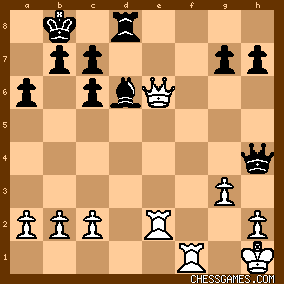
click for larger viewSpielmann rejected <20...Bxg3> for the passive <20...Qd4> and resigned soon after in a position bereft of any prospects. . . .
Game 2 This game was Spielmann's only win in the match. Playing Black in a Scotch Opening, he played accurately keeping a momentum and Teichmann never quite equalised. Teichmann was outmanoeuvred and sacrificed a Knight for two pawns, but then found the ending too difficult to hold over the broad. This well-played win equalised the scores and it would have seemed that the chances for victory in this match were finely balanced. . . .
Game 3 This game, which was the most published game of the match, was a disaster for Spielmann. Spielmann defended with the Sicilian Defence, which was not and would never be part of his regular repertoire (11), and was crushed in 19 moves. Teichmann played actively and showed that he could combine with deadly effect: 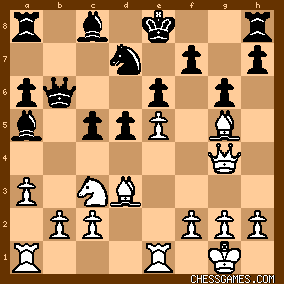
click for larger view<15. b4!> xcxb4 16.Nxd5! exd5 17. e6 f5 18. exd7+ Kxd7 19. Bxf5!! . . .
Game 4 Spielmann as White gained the advantage in a Two Knight's defence. In a similar manner to Game 2, he built up an advantage by fastening onto Teichmann's weaknesses, in this case a doubled <e> pawn. Unfortunately, on the cusp of his second win, he miscalculated 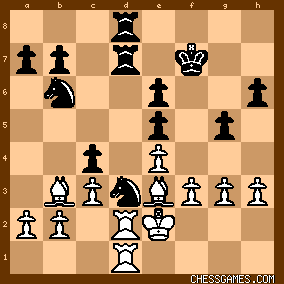
click for larger viewAfter <34.Bxc4?> instead of <34.Bxb6!>, he lost the exchange for a pawn and he could not hold the ending. . . .
Game 5 Two games down with two games to play and with the Black piece, Spielmann threw caution to the wind. He defended against the Ruy Lopez with a Delayed Schielmann variation previously used by Frank Marshall
(Games Like Teichmann vs Spielmann, 1914). Spielmann had only played this early <f5> thrust twice before: P Leonhardt vs Spielmann, 1908 and L Asztalos vs Spielmann, 1913. In both games, he had broken through his opponent's King-side. On this occasion, the quality of his opponent was higher. Teichmann sacrificed a piece for a sudden King-side attack. 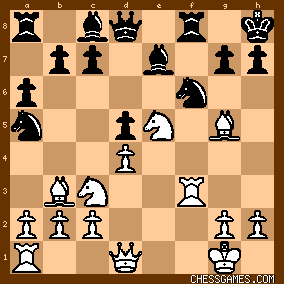
click for larger view<13.Bxd5>
Winning the material back, Teichmann kept the pressure on and won with a neat combination to win Spielmann's Rook. . . .
Game 6 Teichmann had won the match, but Spielmann had not given up. He had the White pieces and the chance to reduce the deficit to 4-2. Spielmann played too aggressively in the opening. 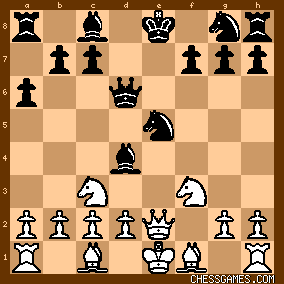
click for larger viewWhilst <9.Nxd4> was equal, Spielmann tried to whip up complications with <Nb5?!>. The idea was to force the Bishop away from protecting <Ne5> by <c3> and so winning the piece back. Instead, he was left with a prospect-less position in which his minor pieces had few good squares. Teichmann steered the game into a Rook and Pawns ending in which he was two good pawns up and won without encountering any significant problems. . . .
Notes:
(1). Café Kaiserhof (Leipzig) Barfussgässchen 15-Am Märchenbrunnen, see https://www.plakatkontor.de/ivpda-p... Leipzig had a thriving café culture, where its habitués were known as the "Kaffeesachsen" (Saxony's coffee-drinkers). (2). "Classical Chess Matches: 1907 -1913", p.225. Fred Wilson, Dover Publications. The historical source of this book is "The Year Book of Chess" for 1914. (3). "Linlithgowshire Gazette". Friday 20 March 1914, p.7. (4). "Stirling Observer ", Tuesday 17th March 1914, p.8. (5). http://www.ansichtskarten-markt.com... (6). Lasker in "Pester Lloyd", 5th October 1913, p.10. These remarks were in relation to (bad chessgames.com link) (7). Milan Vidmar (in the tournament book Karlsbad 1911) quoted by Michael Negele in "Genug des Stumpfsinns, Remis … Richard der Fünfte kam aus Altenburg" https://www.schachbund.de/news/genu... (8). Capablanca wrote in the "Capablanca-Magazine" of 30th September 1914, p.113-114. (9) "Capablanca in the 'Evening Post' (New York), 22nd July 1916, p.9. (10). http://www.chessmetrics.com/cm/CM2/... (11). See http://www.chessgames.com/perl/ches... This text and original research by User: Chessical. I have used some German newspaper sources identified by User: Karpova Proof reading and corrections by User: OhioChessFan
| 


